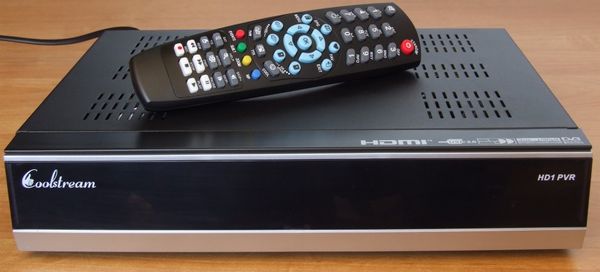Hardware:Coolstream
Inhaltsverzeichnis
[Verbergen]- 1 Allgemeines
- 2 Varianten
- 3 Revisionen
- 4 NeutrinoHD GUI
- 5 Fernbedienung
- 6 Anschlüsse
- 7 Innenleben
- 8 Links
Allgemeines
Die HD1 ist der erster Receiver der Herstellers Coolstream. Da auf dem Receiver der HD-Nachfloger der beliebten GUI Neutrino zu Einsatz kommt, wird dieser auch gerne als dbox3 bezeichnet.
Folgende Eigenschaften zeichnen den HD1 aus:
- Erster HD-Receiver mit NeutrinoHD GUI
- Deinterlacer mit Bildausgabe bis zu 1080p
- Extrem schnelle Umschaltzeiten
Varianten
Die Coolstream HD1 als SAT und Kabel-Varianten.
HD1 S
HD1 C
Revisionen
Auflistung der Hardwareänderungen die an der HD1 durchgeführt wurden.
Rev.1
- Modellname: HD1 BSE (BLACK STALLION EDITION)
- Tuner: SAT
- Release:
Änderungen:
- Gehäuse in Klavierlack lackiert
- Frontblende aus härterem Acrylglas
- Bedientasten (unter Frontblende) in Silber
- Leiserer Lüfter verbaut (20dB)
Rev.2
- Modellname: HD1 C
- Tuner: Kabel (erste Kabelversion)
- Release: 25.01.2010
Änderungen:
- Gehäuse mit mehr Lüftungschlitzen
- Prozessor passiv gekühlt
- eSATAp Anschluß rückseitig (anstatt eSATA) - Dieser beinhaltet einen USB Anschluß und eine 5V Stromversorgung für externe Festplatten (2,5")
- Modemanschluß
NeutrinoHD GUI
Auf der HD1 kommt NeutrinoHD als GUI zum Einsatz und ist somit der erste (und bislang einzigste) HD-Receiver auf dem diese GUI verwendet wird.
Fernbedienung
Anschlüsse
Die DBox2 verfügt über diverse Anschlussmöglichkeiten. Hier kann z.B. ein Fernsehgerät, eine Stereoanlage, ein Videorekorder, ein Telefonanschluss oder ein Netzwerk angeschlossen werden.
HD1 S
Vorne
- Gerätedisplay 12-stellig
- Diverse Bedientasten
- USB 2.0 Anschluß
- Smartcardreader (Conax)
- Common Interface CI (2 Steckplätze)
Hinten
- Netzkabel (100V-230Volt / 50Hz/60Hz / 30W max.)
- Netzschalter
- SATA (Festplattenanschluss ohne Stromversorgung)
- Ethernet (RJ45 - 100MBit/Full-Duplex)
- HDMI 1.3
- S/P-DIF (Optischer Digitalausgang)
- Scart (1x TV)
- RS 232 (Serieller Anschluss)
- Stereo RCA (Cinch) Output
- Video FBAS (Cinch)
- Component (Cinch)
- LNB IN (13/18Volt / 500 mA max.)
- LNB OUT
HD1 C
Vorne
- Gerätedisplay 12-stellig
- Diverse Bedientasten
- USB 2.0 Anschluß
- Smartcardreader (Conax)
- Common Interface CI (2 Steckplätze)
Hinten
- Netzkabel (100V-250Volt / 50Hz/60Hz / 45W max.)
- Netzschalter
- E-SATA-P/USB (Festplattenanschluss mit Stromversorgung)
- Ethernet (RJ45 - 100MBit/Full-Duplex)
- RJ11
- HDMI 1.3
- S/P-DIF (Optischer Digitalausgang)
- Scart (1x TV)
- RS 232 (Serieller Anschluss)
- Stereo RCA (Cinch) Output
- Video FBAS (Cinch)
- Component (Cinch)
- RF IN
- RF OUT
Innenleben
Prozessor Chip NXP/Philips CX24500
Video Decoder MPEG-2/H.264/VC-1
- Capable of decoding an HDTV program in the following formats: MPEG-2 MP@HL, MP@ML. MP@LL, SP@ML, AVC HP@L4.1, VC-1 AP@L3 and MP@HL
- Supports decoding for picture sizes up to 1920x1080 @ 30fps; supports all ATSC, DIRECTV, DVB and SCTE formats
- Supports OpenCable HDTV constrained image output on YPrPb
- Supports Advanced DTV closed captions according to EIA-708-B
- Supports Analog closed captions per EIA-608
- Supports MPEG-1 video decoding with up-sampling and filtering of low resolution video modes to full CCIR601 picture size
- Supports 14:9, 16:9 and 20:9 image aspect ratios through pan/scan or letterboxing
- Supports 3:2 pull-down of 24fps video sequence
- Supports video trick modes for PVR applications
- Automatic error concealment
Audio Decoder
- Program decoding of MPEG-1, MPEG-2, Dolby Digital, Dolby Digital Plus, MPEG-2 AAC, MPEG-4 AAC, aacPlus and WMA encoded bit-streams
- Decodes MPEG-1 Layer I and II (MUSICAM) ISO 11172
- Supports MPEG-1 Layer 3 (MP3) decode
- Supports Windows Media Audio v.9 and WMA Pro decoding
- Supports transcoding of Dolby Digital Plus with downmix to 2-channel stereo and Dolby Digital transcode
- Supports transcoding of aacPlus with down-mix to 2-channel stereo and DTS transcode
- Stereo down-mix extraction from multi-channel MPEG-2 source
- Up to 4-bit LPCM 2-channel output in I2S or left justified serial formats
- Supports sample rates of 16, 22.05, 24, 32, 44.1, 48kHz
- Stereo 24-bit audio DAC for analog audio output
- Automatic error concealment
- A/V synchronization using PTS and STC
- 2-channel ProLogic encoded Dolby Digital down-mix output via I2S and integrated stereo audio DAC
- Single program encoded bit-stream output on S/PDIF port
CPU ARM1176EJ-S
- 736 Dhrystone 1.24 MIPS at 594MHz
- 32 kB data cache, 32 kB instruction cache
- Linux/WinCE compatible MMU
- Java support through ARMs Jazelle technology
RAM Chips
384 MB DDR2-667 RAM
Flash Chips
32 MB Flash Memory
Tuner (Frontend)
DVB-S (Satellit)
Der in der SAT-Variante verbaute Tuner ist von Sharp (BS2F7VZ0169)
- Demodulator STV0903BAB
- Tunerchip STV6110A
DiSEqC
Die HD1 S unterstützt DiSEqC 1.0, 1.1, 1.2, 1.3 USALS
DVB-C (Cable/Kabel)
Die DVB-C Variante ist seit Ende Januar 2010 verfügbar!
DVB-T (Terrestrisch)
Eine DVB-T Variante der HD1 ist nicht vorgesehen.
HDMI-Transmitter
Ausgangsformate:
- YCrCb gemäß ITU-R BT.601 (für SD)
- YCrCb gemäß ITU-R BT.709 part 2 (EIA 770.3 / SMPTE 274M / SMPTE 296M) (für HD)
- YCrCb 4:2:2 (12 bit für Y und 12 bit für C)
- Full Range RGB (8 bit pro Kanal mit Wertebereich von 0 bis 255)
- Limited Range RGB (8 bit pro Kanal mit Wertebereichvon 16 bis 235)
Eingangsformate:
- Am Eingang bekommt und akzeptiert er ausschließlich 10-bittiges YCbCr 4:4:4 gemäß ITU-R BT.601



